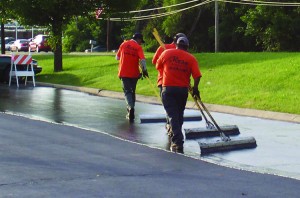Paving 101

Have you ever been confused by the terminology used in the paving industry? Understanding the language of paving can be quite challenging, especially when you’re trying to ensure the best results for your parking lot or driveway. Whether you are a property owner, facility manager, or just someone interested in learning more about paving, this guide will help clear things up for you. Here, we will go into some commonly used paving terms, giving you a solid foundation of knowledge to help you make informed decisions during your next paving project.
Key Paving Terms
ADA The Americans with Disabilities Act
This federal act was passed to ensure uniform compliance with standards for the benefit of those with disabilities. Its scope encompasses everything from the width of doorways to the use of Braille in elevators. Concerning pavement, there are standards for disabled parking, access aisles, curb ramps, signage and markings, etc. Some states and municipalities also have laws that regulate proper accessibility for people with disabilities.
Aggregates
Usually, various-sized stones, crushed rock, gravel, etc. make up approximately 92-96%of the asphalt mixture. (Asphalt cement makes up the other 4-8 %.)
Asphalt
Asphalt, often referred to by its more technical name “Bituminous Asphalt Concrete,” is also known as “flexible pavement.” This material is a mixture of aggregates and hot asphalt cement. Asphalt forms the smooth, durable surface commonly seen on roads, parking lots, and driveways when placed, compacted, and subsequently cooled. Its flexibility allows it to withstand various weather conditions and traffic loads, making it a popular choice for many paving applications.
Asphalt Base
Asphalt mix where the largest stone used is no larger than 3/4 of an inch (typically #57 gradation). Base mixes are usually laid over a stone base (at a minimum depth of 2 inches compacted) and applied prior to surface material.
Asphalt-Based Sealers
A mixture of slow-setting emulsified asphalt, fine aggregate, and mineral filler with a slurry consistency.
Asphalt Binder
The asphalt layer between the base layer of rock or other aggregate and the driving surface layer. The asphalt binder layer is usually made up of coarser materials and is usually thicker than the surface layer. The binder layer can be used as either a first layer or a driving surface, but its use is fairly limited. The vast majority of jobs call for a stone base layer, an asphalt base layer, and a surface layer.
Asphalt Cement
A petroleum byproduct used to “glue” the pavement together. By volume, this material makes up about 4-8% of the pavement mixture. (Aggregates make up the other 92-96%)
Base Failure
Base failures occur when the layer beneath the binder layer and driving surface can no longer adequately support the weight of the structure or the traffic. Base failures can occur for a number of reasons including groundwater, excessive load counts (too much weight), and inadequate design. The failure can be corrected by excavating the failed material and replacing it with bridging stone material.
Blacktop
Blacktop is a common slang term for asphalt. However, this term should not be used when requesting specifications or work, as its meaning can vary significantly across different regions. In some areas, “blacktop” may refer to a penetration pavement or a hot oil treatment, leading to potential confusion.
Coal-Tar
A by-product of coke ovens in the steel production industry. Refined coal tar has been used as a base for asphalt pavement sealers since 1938.
Compaction
Compressing a given volume of material into a lesser volume. A compacted sub-grade and base are essential.
Concrete
Concrete, commonly known as “Portland Cement Concrete Pavement,” is a hard, compact building material formed when a mixture of cement, sand, gravel, and water dries. Concrete is known for its strength and durability, making it an ideal choice for heavy-duty applications such as highways, sidewalks, and parking structures.
Cracking
Cracking refers to the separation or splitting of the asphalt layer. This can occur due to various factors, including excessive loads, extreme temperatures, or the natural aging process of the asphalt. Cracking is a common issue in asphalt pavements and can lead to further deterioration if not addressed promptly.
Drainage
A system of drains and pipes for carrying away surface water. An asphalt surface is sloped to maximize the removal of surface water for vehicular safety.
Emulsion
An emulsion is a mechanically produced combination of ingredients that do not normally mix. For instance, asphalt emulsions are created by mechanically milling warm asphalt into minute globules, dispersing them in water, and adding a small amount of an emulsifying agent. Emulsions are often used in various paving applications, such as tack coats and seal coats, to improve adhesion and protect the pavement.
Full-Depth Asphalt Pavement
The process of constructing an asphalt pavement structure using asphalt products for all components. The base material and surface courses are all made up of appropriately specified grades of hot-mix asphalt in contrast to conventional paving using crushed stone materials, etc.
Infrared
Asphalt surface repair process which uses radiated heat to soften existing pavement. This allows fast repairs with less new material and facilitates repairs in weather too cool for conventional methods. Not appropriate for areas of base failure or requiring structural repair. May be used to soften pavement prior to texturing.
Joints
An asphalt joint is the area where two different “pulls” or applications of asphalt meet. This area is usually highly visible after the paving operation and is sometimes called a “seam.” Properly constructed joints are crucial to the integrity and longevity of the pavement.
LEED° (Leadership in Energy and Environmental Design)
Developed by the U.S. Green Building Council, LEED is an internationally recognized green building certification system, provides third-party verification that a building or community was designed and built according to standards for environmentally sustainable construction.
Low VOC
Typically used in reference to lot marking paints. In order to be defined as Low VOC, paint must release below 150 g/liter and be virtually odor-free.
Overlay
Overlay is the practice of placing new asphalt over an existing asphalt or concrete surface. This process, also known as resurfacing, can extend the life of the pavement, improve its appearance, and provide a smoother driving surface. Overlays are a cost-effective way to rejuvenate worn-out pavements without the need for complete reconstruction.
RAP (Reclaimed Asphalt Pavement)
Often considered for economic and environmental reasons, RAP refers to ground asphalt which is added back into a virgin asphalt mixture at the mixing plant. Recycled pavements may have different performance characteristics than conventional mixtures. Larger contracts today should specify if the use of RAP materials is encouraged, allowed, or not allowed.
Reflective Cracking
Reflective cracking occurs in asphalt overlay pavements when cracks in the existing pavement reflect up through the new overlay. This can be mitigated using specialized techniques and materials such as multi-membrane paving fabrics, which help to minimize reflective cracks.
Routing
Enlargement of pavement cracks using a specialized machine to provide a uniform-width reservoir for sealant. Proper choice of bit size results in a proper depth-to-width ratio. Routing can greatly increase the effectiveness and durability of crack sealing.
Seal Coating
Seal coating involves the application of a sealant, usually a coal-tar emulsion or asphalt emulsion, to preserve, protect, and beautify asphalt pavements. Seal coating is typically used on low-traffic streets or off-street locations like parking lots to extend the life of the pavement and enhance its appearance.
Slope
The slope of a paved surface refers to the degree to which it is angled to aid in the drainage of water. A proper slope is essential to prevent water from pooling on the surface, which can lead to pavement damage and safety hazards.
Solar Reflectivity
Solar Reflectance Index (SRI) is a measure of the constructed surface’s ability to reflect solar heat, as shown by a small temperature rise.
Stormwater Management
The management of stormwater runoff. often using water retention facilities, to provide a controlled release into receiving streams. Storm- water runoff occurs when precipitation from rain or snowmelt flows over the ground.
Sub-grade
The sub-grade is the soil prepared to support a structure or a pavement system. It serves as the foundation for the pavement structure, and its stability and proper preparation are crucial to the performance and longevity of the pavement.
Sub-grade Failure
Occurs when the prepared soil beneath the asphalt structure can no longer adequately support the weight of the structure or the traffic. This happens for several reasons including ground water, excessive load counts (too much weight), and inadequate design. It can be corrected by excavating the affected area and replacing it with compacted soil or bridging stone material.
Surface
Asphalt mix where the largest stone used is no larger than 1/8 an inch (typically #8 gradation). Surface mixes are usually laid at a min. depth of 1inch compacted.
Sustainability
Development that meets the needs of the present without compromising the ability of future generations to meet their own needs.
SWPPP (Storm Water Pollution Prevention Plan)
A written plan implemented during the construction or reconstruction of a site that reduces or eliminates erosion and sedimentation. This plan is typically guided by local, state, or federal guidelines.
Tack Coat
A tack coat is a layer of asphalt oil, usually an emulsion type, applied to existing pavement during repairs or overlay paving. Its purpose is to create a bond between the old and new asphalt layers, ensuring that the new pavement adheres properly and remains intact over time.
Tracking
The result of products or materials being “picked up” by car tires, shoes, and shopping cart wheels and carried from the pavement or “tracked” onto surfaces where the material is not desired.
Additional Paving Terminology
Aggregate
Aggregate refers to the granular materials, such as sand, gravel, or crushed stone, used in the composition of asphalt and concrete. Aggregates provide structural stability and contribute to the overall durability of the pavement.
Base Course
The base course is the layer of material installed directly on top of the sub-grade. It provides the foundation for the asphalt or concrete surface layer, providing additional support and load distribution.
Binder
A binder is an intermediate layer of asphalt between the base course and the surface layer. It is typically made of coarser materials and provides structural strength and stability to the pavement.
Hot Mix Asphalt (HMA)
Hot Mix Asphalt (HMA) is a type of asphalt produced at high temperatures and used in various paving applications. HMA is known for its durability and ability to withstand heavy traffic and extreme weather conditions.
Milling
Milling is the process of removing the top layer of asphalt to prepare the surface for a new overlay. This technique helps to maintain proper pavement thickness and improves the bonding of the new layer.
Porous Asphalt
Porous asphalt is a type of asphalt designed to allow water to pass through the surface and infiltrate into the ground below. This environmentally friendly option helps to reduce stormwater runoff and improve groundwater recharge.
Raveling
Raveling is the progressive disintegration of the pavement surface, where aggregate particles are loosened and lost. This issue can result from inadequate compaction, poor-quality materials, or environmental factors.
Rutting
Rutting refers to the formation of grooves or depressions in the pavement surface, typically caused by heavy, repeated traffic loads. Proper design and construction practices can help prevent rutting.
Slurry Seal
A slurry seal is a mixture of asphalt emulsion, water, aggregate, and additives applied to the pavement surface to fill cracks and provide a new wearing surface. Slurry seals are commonly used for preventive maintenance on low-traffic roads.
Structural Capacity
The structural capacity of a pavement refers to its ability to withstand traffic loads without experiencing significant deformation or damage. This capacity is determined by the materials used, the thickness of the layers, and the quality of construction.
Have Rose Paving Solve All Your Paving Needs
Understanding these paving terms will help you confidently navigate your next project. Whether you’re discussing repairs, maintenance, or new installations, being familiar with this terminology will ensure you communicate effectively with contractors and make informed decisions.
If you have any questions or need professional paving services, don’t hesitate to reach out to Rose Paving. Our experts are here to assist you with all your paving needs. Contact us today at Rose Paving to get started on your next project.




